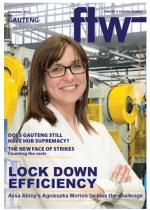South African importers
are, generally speaking,
very small players in the
global supply chain and are
located far away from their source
markets. Subsequently, they face an
uphill battle to get products to their
customers at the right time and at
the right price.
Keeping the total
cost of ownership
down – which
includes a quick
turnaround on
production
and delivery
– is heavily
dependent on
an efficient,
flexible and
streamlined
supply
chain, said
Agnieszka Morton, newly appointed
procurement manager for Assa Abloy
in South Africa, a global specialist
in the manufacturing and supply of
door opening solutions. “Decisions
need to be based on the total supply
chain cost rather than on a low
purchase cost,” she added.
The company has several door
opening solutions in its stable,
ranging from padlocks to sliding
door locks, electronic access control
locks, mechanical locks and more.
Well-known brands, which form
part of the Assa Abloy portfolio,
include Yale, Henderson,
Union, Besam, Vingcard
and Mul-T-Lock Customers
include retailers, wholesalers,
locksmiths and Original
Equipment Manufacturers
(OEM).
The manufacturer has a
large production facility in
Roodepoort, Johannesburg,
where it manufactures
the majority of its
products. “We ship a
lot of our products
nationally and
into parts of Africa from the Gauteng
warehouse,” said Morton.
Assa Abloy imports materials,
components and sometimes fully
assembled products from other Assa
Abloy companies across the globe.
Morton noted that the majority of the
South African imports were currently
sourced from emerging markets
such as India, China and Eastern
European countries such as Poland,
Romania and the Czech Republic.
“We find these countries offer
good-quality products at competitive
prices Yet there are several challenges
for importers in South Africa,
not least of which are low levels
of responsiveness from source
countries. It is crucial to align with
the right suppliers as we need enough
presence in their companies to build
a strategic partnership in order to
obtain transparency on costing or
price projections. We also need to
establish the right relationships so
we can collaborate and get answers
when deliveries are delayed,”
commented Morton.
Furthermore, emerging markets
are highly volatile and are subject to
sudden economic
changes and
labour policies,
she said. “For
example, the cost
of labour in China
has substantially
increased over
the past few
years, which
adds to the cost
of the products
or materials.” China is no longer
regarded as the ‘cheapest’ country
to manufacture goods. Cost
competitiveness around the globe
has drastically changed over the past
decade. South Africa’s location also
counts against it for importers as
the lead times for products are quite
long. “Depending on the nature of
the product, there is an average of 30
days’ production lead time and then
it takes around 4 to 6 weeks by sea
to reach Durban port,” Morton said.
She added that ocean freight was the
preferred method of transport as it
was most cost-effective. “Airfreight is
mainly used for urgent deliveries .”
High logistics costs and excessive
inventory can dilute the benefits
of low cost sourcing. To overcome
these challenges and ensure a more
efficient and cost-effective supply
chain, Morton suggests importers –
and their freight forwarding partners
– look at more consolidation and
improved collaboration between
internal and external suppliers in
order to pool resources and gain
maximum savings benefit.
Transparency is also a key
deliverable from freight forwarders
and agents, particularly because
of the length and complexity
of an import supply chain said
Morton. Collaboration between
companies and suppliers is critical
to global success. True partnerships
require transparency and clear
understanding of requirements and
expectations driven by an agreed set
of Key Performance Indicators.
INSERT & CAPTION
Decisions need to be based
on the total supply chain
cost rather than on a low
purchase cost.
– Agnieszka Morton

